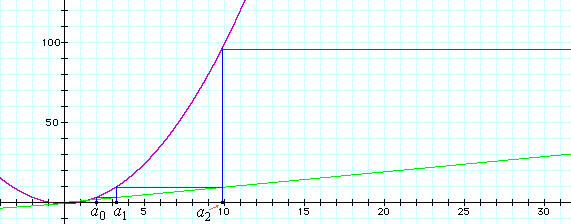It seems to need to be bound...............or it spirals off to infinity..........bound......like the strings of a violin..................string theory..........m theory??
Here's the graph of the iterates starting with the initial value
a0 = 2.0. The graph is colored in the same way, but it's drawn to a different scale. This time, the iterates run off to infinity; they don't remain small.

Thus, what happens in the long run depends on the initial value
a0. It's easy to show that if the initial value
a0 is greater than 1.5, then the iterates run off to infinity, like they did when
a0 was 2.0. Also, when the initial value
a0 is less than –1.5, then, since after one iteration
a1 is greater than 1.5, the iterates go off to infinity. With more work, you can show that if –1.5 <
a0 < 1.5, then the iterates approach –0.5, like they did when
a0 was 1.0. The remaining two initial values, namely 1.5 and –1.5, have all their iterates equal to 1.5. So the set of real numbers is partitioned into two parts, the closed interval [–1.5,1.5] of initial values whose iterates remain bounded, and the rest of the real numbers whose iterates do not remain bounded but approach infinity. This is shown graphically below. The real line is partitioned into the two sets with the interval [–1.5,1.5] drawn in light yellow, the rest in pink. We'll call the set of initial values whose iterates remain bounded the
filled-in Julia set, or simply the
Julia set for short. Thus, the light yellow set is the real Julia set for the function
f(
x) =
x2 – 0.75.


No comments:
Post a Comment